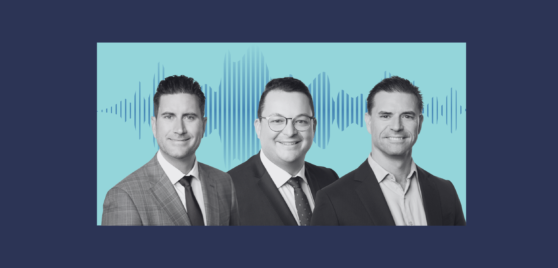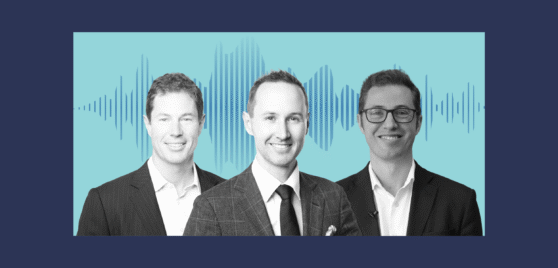Featuring Daniel Moore and Michael O'Neill
WATCH
READ
Portfolio managers Daniel Moore and Michael O’Neill provide an update on IML’s large caps funds and Equity Income Fund in light of the current market volatility.
This video was recorded on April 4, 2025
Download slidesLightly edited transcript:
Daniel Moore: Today, we wanted to give you all a bit of a presentation update on the funds, the IML large cap funds, given the recent market volatility and, a number of announcements on the tariff front. And, we’re pleased to say straight away that the funds are navigating these markets, quite well, and returns for our large cap funds are still in positive territory for the calendar year despite all the volatility. So, performing as you’d expect.
If we go to the first slide, the market backdrop. Before we talk about what’s going on right now, I think it’s important to talk about where we’ve come from. And, we’ve come from, over the past year or two, very strong equity markets. Which have been particularly narrow, driven by the tech sector overseas and data centres, and more domestically, the banks and financials have driven 80% of the return last year, for example. So very strong, but narrow markets. Valuations have also been rising in the face of high bond yields. And while the market PEs are very high. It’s important to note not all stock valuations are high and we’ll go through that a bit later.
Daniel: And I guess what’s really sort of on everyone’s lips at the moment, is tariffs and we’ve seen some significant tariff increases, announced recently from Trump providing a lot of volatility in markets. Fortunately, our portfolios are not, overly exposed to any of those tariffs, we’ve navigated that quite well. Really in the Australian context, the big exposures are Orora, Fisher & Paykel [Healthcare], and Ansell, which we don’t have exposure to in the funds. The only real exposure we have is ResMed, which has their manufacturing bases in Singapore. They’ve got a ten percent tariff. So nothing significant. Their competitors have far worse tariffs in China. So the portfolio has been fortunate from that perspective. There’s also been other risks emerging in markets we’re seeing in 2025. And 2025 has been a very different year to 2024. And, we’re seeing some government spending cuts jitter markets, and also data centre oversupply concerns with the Microsoft CEO, relaying some concerns about the amount of data centres that are getting supplied and pulling out of some leases of new data centres as well, which has seen data centre stocks have some pretty large falls this calendar year.
Michael O’Neill: And so looking back it is fair to say 2024 was a year of patience and discipline. But if you are a longer term investor focused on value and quality, the tides are turning. No longer, are momentum forces and thematics driving the market, but valuation is starting to matter again. And in-depth research, is starting to pay off as volatility returns to the market. So look, it’s early days, but certainly, there are forces driving high volatility that look like they shall persist. And why is that? Well, one of the big reasons that we see on the next slide is valuations, close to historic highs. The market is vulnerable, to volatility because stocks are expensive. If you look at the industrial PEs, you strip out the resource stocks, which tend to be more volatile because the PEs move with commodity prices. We’re back at levels of around 21 market PE, similar to what we had in 2021 calendar year. But importantly, today bond yields are higher. Back then they were zero. So, arguably, we’re at more extreme levels. Part of that’s been the banks driving the high component of the returns. They were actually up 35% in the (2024) calendar year on roughly zero earnings growth. So you can see why the market has been vulnerable to a return of volatility.
Daniel: And when we look at equity market valuations relative to bonds, which is reflected in the equity risk premium, we see the equity risk premium at an all time low in Australia. And just to be very clear, the equity risk premium is the earnings yield of the market less the ten year bond yield. So that’s the spread you earn in equities over bonds for taking on the risk of investing in equities. And last year, that spread got to a record low, showing I guess, the vulnerability of markets not pricing in much risk at all. And it was part of the reason the correction is probably as large as we’re seeing right now, in markets. Fortunately given our low risk approach to investing, our conservative disciplined approach, when the equity risk premium normalises to more normal levels, that tends to lead to a good environment for our funds in terms of outperforming. And Mike and I, when we joined IML, we were fortunate enough to join in 2010. And you can actually see in 2010, the equity risk premium was very similar to today. And as that equity premium normalised over the next 7-8 years, our funds outperformed, I think 7 of the next 8 years. So, where we are right now, we feel the funds are in in a really good position to deliver good outperformance for clients in the years ahead.
Michael: So the good news is even though the market looks expensive, not all stocks are expensive. If you carve up the market into quintiles, you can see the top quintile, the top line there, is where the PE expansion has really occurred. The high PE stocks have gotten even higher because of momentum, and that top quintile’s back around 50. So as you’d imagine with some stocks priced to perfection. We certainly saw in reporting season, those that had a little mis-step correcting 20-30%, in many cases. The part of the market where we invest being focused on value as well as quality is that second or third quintile, there’s a lot of stocks at market PE or even lower, stocks like Brambles, Steadfast and Amcor, with a good growth outlook, which look quite reasonably priced. So if you look at what happened in reporting season, we can carve out some key winners on the left hand side, stocks in our portfolio. And, really, the theme was, the refocusing of the market away from momentum and towards quality, defensive, industrial businesses that have recurring earnings. One highlight was Brambles. It’s now delivered a fourth year of double-digit earnings growth and still on a quite reasonable valuation.
Daniel: And then I guess if we go to the other side of the ledger, we go to the key losers. Some key themes there. Lots of tech stocks that were trading at very high valuations, companies exposed to data centres, as well, stocks that were exposed to US housing that were on high valuations such as Reese, and we’ve seen Hardies more recently in March, also had a tough time. Our portfolios don’t own any of those stocks. We did have one black mark, however, in the portfolio in reporting season, and that was Viva Energy. But excluding, well, even including Viva Energy, it was a good month for the funds, in a market that was down 3.8%, we had a good month.
Just quickly, we also wanted to give a bit of a performance update, for the large cap funds. Pleased to say the recent few months of volatility, the funds have held up quite well. And, if we were to have given this presentation at the end of January, I think our funds were 6% behind the benchmark. Given the strength in equity markets and the narrowness of the rally, I’m pleased to say we’ve turned a lot of that performance around quite quickly. And also happy to announce that in April, with all the tariff announcements, the funds have held up very well, in the face of that. So, still plenty of work to do but the funds are, I guess, performing in the manner you’d expect.
Michael: It’s been a similar experience with our Equity Income Fund, as you’d imagine, a portfolio of companies with low risk and a growing profile of dividends, more defensive hold up well in this environment with a return of volatility. So it’s certainly we’re pleased in the relative performance of this fund. But the total return of the fund is not the whole story for the income fund. It’s not all about total return. What’s really important as volatile markets return, is that, you know, our funds deliver on income objectives as well as capital preservation. And if you take a scenario where someone is not a natural re-investor of dividends, so you’re a retiree reliant on our income fund for your lifestyle. And you look at a scenario based on comfortable living standards.
Had you invested in the ASX300 over the period since our income fund’s inception, you would be significantly worse off. You’d be 40% underwater in a capital sense. And why is that? Well, our income fund delivers a superior income, which is paid quarterly. It’s diverse in the sources, so it tends to be steady even in tough periods where dividends are challenged. And it’s also got a lower capital volatility, to begin with. So those combined factors mean that you can rely on this, fund to deliver an income in tough periods and not have to, be as much of a seller of dips, and it has a significant impact on your outcomes as a retiree investor. And with that, this ends our presentation, and our update, we thank you for your support. We want to leave you with one message, which is reassuringly, IML funds are behaving as you’d expect, with volatility returning in markets. Thank you.
Daniel: Thank you.
This publication (the material) has been prepared and distributed by Natixis Investment Managers Australia Pty Limited ABN 60 088 786 289 AFSL 246830 and includes information provided by third parties, including Investors Mutual Limited (“IML”) AFSL 229988. Although Natixis Investment Managers Australia Pty Limited believe that the material is correct, no warranty of accuracy, reliability or completeness is given, including for information provided by third party, except for liability under statute which cannot be excluded. The material is for general information only and does not take into account your personal objectives, financial situation or needs. You should consider, and consult with your professional adviser, whether the information is suitable for your circumstances. Past investment performance is not a reliable indicator of future investment performance and that no guarantee of performance, the return of capital or a particular rate of return is provided. It may not be reproduced, distributed or published, in whole or in part, without the prior written consent of Natixis Investment Managers Australia Pty Limited and IML. Statements of opinion are those of IML unless otherwise attributed. Except where specifically attributed to another source, all figures are based on IML research and analysis. Any investment metrics such as prospective P/E ratios and earnings forecasts referred to in this presentation constitute estimates which have been calculated by IML’s investment team based on IML’s investment processes and research. The fact that shares in a particular company may have been mentioned should not be interpreted as a recommendation to either buy, sell or hold that stock. Any commentary about specific securities is within the context of the investment strategy for the given portfolio.
INVESTMENT INSIGHTS & PERFORMANCE UPDATES
Subscribe to receive IML’s regular performance updates, invitations to webinars as well as regular insights from IML’s investment team, featured in the Natixis Investment Managers Expert Collective newsletter.
IML marketing in Australia is distributed by Natixis Investment Managers, a related entity. Your subscriber details are being collected by Natixis Investment Managers Australia, on behalf of IML. Please refer to our Privacy Policy. Natixis Investment Managers Australia Pty Limited (ABN 60 088 786 289) (AFSL No. 246830) is authorised to provide financial services to wholesale clients and to provide only general financial product advice to retail clients.






